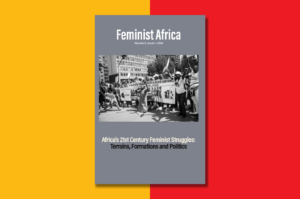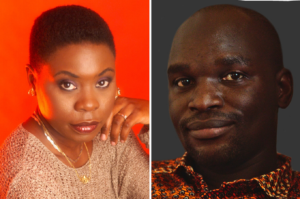I
African writers write to the west is both a popular complaint and the reality of the continent’s literature. And so far, the African writer, whoever she may be, has reacted rather predictably. First, carp, carp, carp. Second, submit to a foreign publication or enter for a western prize. This may be hypocrisy in most reference books. To the writer, though, it’s merely a way of life.
So here’s a question: if the west is destiny—in terms of publishing, prizes and prestige—which of today’s writers has the most attractive resume? Each country has its candidates. In Nigeria, the obvious ones are Chimamanda Ngozi Adichie and Teju Cole, the country’s dynamic duo. Others follow behind.
The dark horse is Nneka Lesley Arimah, whose work has featured in major literary publications. New Yorker, Granta, Harper’s. She has now arrived at the Caine—that wonderfully prestigious prize for African writing bestowed by the west. Chuffed or miffed, the continent’s literati care about Caine. Perhaps New Yorker staff writer Alexis Okeowo, who has been in Granta, should be added to the list; but as it stands, she has less a literary bent than a journalistic one. Also, she isn’t quite known.
Arimah is known, if a tad distant. Over on Twitter, she courted some extracurricular attention, getting into an extended exchange so sensational it ended up on a humor website. Initially perceived as a writer of the realistic school of fiction with “Light,” the story that brought Nigerian attention to her yard and the Commonwealth Prize prize money to her purse, Arimah’s publishing history shows she possesses other tricks. Never fully spiritual in the Nigerian religious sense and never purely rational in the western sense, some of her major stories have been, as far as the list on her website goes, fantastic in both senses of the word.
File this one under Speculative Fiction Writer then.
II
In one of her more unusual stories, the New Yorker published “Who Will Greet You at Home,” Arimah created a universe of women—something this critic, being male, took personally. The story proceeds as one woman seeks to produce the perfect child using different materials. Gradually, the story becomes horror, elevated from pulp-terror by Arimah’s language and an unhurried approach to reaching its climax. Her Caine Prize nominated tale, “What It Means When A Man Falls From The Sky” takes its time as well and—thankfully—men exist here, even if the titular male is dead on arrival.
The story opens with a press conference where an explanation is proffered for the death of the unnamed man. The place is New Kenya and time is the future—where the world is operated by the “constant and absolute” science of mathematics. The death of this man who falls from the sky is inexplicable and tests the public’s faith in an almighty code called Furcal’s Formular . The custodian of this formular blames the Mathematicians—the interpreters of this code: “Any problems that arise are the fault of those who miscalculate it.”
Nneoma, one of these Mathematicians, has troubles of her own. Her partner has disappeared, but she’s fine as she assures herself and the reader. She works as a human painkiller, absorbing the pain of mostly rich clients. Moments into the story, she gives a lecture at a school. There she is confronted with the limits to her vocation when a kid in extreme pain—“The weight of her mourning was too much”—reaches out to her but turns out to be from Senegal. Procedures involving the assistance of foreigners are prohibited without a large amount of protocol. But filled with pity, Nneoma does the illegal thing by absorbing the overwhelming pain of this alien girl, an action that may contribute to the story’s tragic last scene which calls up familial anguish and the hopelessness of one human alleviating the pain of another.
As with some of her other work, a relationship between two women frames “What It Means” as it does “Second Chances” and “The Future Looks Good.” The same relationship frames “Light,” only mediated by a man. The dominant feature of all of these stories is tragedy and death. A mother comes back to life in “Second Chances”, mystifying one of her daughters. “The Future” waylays the reader and its central character with a gun. “Light” sees the death of the joie de vivre of youth. And by the end of “What It Means,” there is more than one dead body.
File this one under Exponent of the Dark Arts.
Unlike those stories, the central relationship in “What It Means” is between lovers not members of a family. Elsewhere, Arimah has spoken about pushing herself to consider a father and daughter relationship for “Light” rather than that between women. Yet, “What It Means” would represent a greater achievement in pursuing human connection, a subject that is at the heart of the stories of Arimah—if only because here the pursuit is romantic rather than her filial. Why “What It Means” comes to be less of a progress with regards to connection is that until the end, the lovers are kept at arm’s length. Ditto the reader. Where “Light” exchanges its sass and sarcasm for sappy in its last few paragraphs, “What It Means” skips sentimentality and lands on a bordered field marked ‘mechanical.’ By the time the story arrives at the conclusion, at which point the changed, estranged lovers touch, the response is less emotional than cerebral. One is more likely to say, “I see” than “I feel”.
So while “What It Means” shows a fine grasp of technique, the story does feel like the literary product of a time when cold science was prized above all else. Which in almost any other story would be a full-time failure but here, it comes to be proof of Arimah’s grasp of her own technique—in how the story itself never escapes the spare emotional dimensions of its setting.
For all of its futurist features, “What It Means” is useful in today’s world. No doubt, that mathematics is fallible will come to a kind of school pupil as delightful news. Beyond that, though, Arimah’s story upends the typical imagining of the future as a place where only the western hemisphere exists, where humanity is represented by a race without melanin. In “What It Means,” America and Europe have been wiped out.
Most of what had been North America was covered in water and a sea had replaced Europe. Russia was a soaked grave. The only continents unclaimed in whole or in part by the sea were Australia and what was now the United Countries but had once been Africa.
There are no heroes here. If there were, they almost certainly will be female and African—two groups that rarely survive apocalyptic events in popular projections of the future. Perhaps with more stories like “What It Means,” tales undermining common iterations of the future, children of Africa can believe that they, too, will inherit the future. Arimah’s story comes to serve a point made by Neil Gaiman:
...speculative fiction is really good at…the present. Taking an aspect of it that troubles or is dangerous, and extending and extrapolating that aspect into something that allows the people of that time to see what they are doing from a different angle and from a different place.
III
The Elimination began after a moment of relative peace, after the French had won the trust of their hosts. The Senegalese newspapers that issued warnings were dismissed as conspiracy rags, rabble-rousers inventing trouble. But then the camps, the raids, and the mysterious illness that wiped out millions. Then the cabinet members murdered in their beds.
There is a sense in which Arimah has de-dramatized her story. A skilled creator of scenes would milk the above of drama. Arimah favors compression. With passages like this, one thinks of her as storyteller, in the literal sense of the word, someone telling you a story not acting it out. What could span paragraphs is told in a sentence or five.
In today’s ‘show don’t tell’ world, this could be a limitation, especially because unlike, say, Molara Wood, who squeezes meaning from the smallest of incidents and the barest of scenes in her collection of short stories Indigo, Arimah’s tales take place across scenes sometimes spanning years. But as every writer knows, an exceptional member of the tribe is one that makes a virtue of her limitations. Stylists polish every sentence, imbuing them with their own signatures. Writers that favor stories pack in plot and incidence. Arimah’s gift lies somewhere in between: if you conceive of the word storyteller as having a hyphen in the middle, Arimah would fall toward the right of the punctuation mark. The trick is all in the way she tells the story, the particular voice she employs to mediate the narration. In “Light”, the narrator is sassy and sarcastic and affects how the tale is told. In “The Future Looks Good”, the words “doesn’t see what came behind her” anchors the story at intervals until the last bloody scene.
The narration in “What It Means” is subtler. A tale without a lot of clever interruption by narrator, its working gimmick is in how the title is implicated in the tale. In other words, “What it means for a man to fall from the sky” is essentially the first sentence of the story.
IV
One last word on the Caine. That “What It Means” is on the 2016 Caine Prize shortlist is a telling recognition of this writer’s gifts—with the perhaps unintentional baggage of the Caine cashing in on Arimah’s rising star. If the Caine is the principal bringer of new talent to Africa’s notice, how exactly has Lesley Nneka Arimah slipped past the prize all of this time. How come she has only gotten on the shortlist after publishing in respected magazines and secured a book deal? Had she never entered for the prize before now?
Another aspect worth considering is the recent shift by the Caine committee from the famed Caine Prize Aesthetic—that poor, gritty, violent realism it spent years rewarding—to something more, well, experimental. At a glance, it looks a pattern is on the rise. “The Sack”, Namwali Serpell’s dream-like tale, took the prize last year and “Flying”, the dream-filled tale by Elnathan John received a nomination. Aspects of Okwiri Oduor’s “My Father’s Head”, winner of the 2014 prize, share a sense of the experimental as well. Ditto a couple of the stories on this year’s shortlist.
Even with the presence of a writer like Tope Folarin, purveyor of tales of communal and familial dysfunction, popping up on the shortlist twice in under a half-decade, there is a sense in which fresh ground of realism without blood, sweat and tears, has remained mostly untouched by this most desirable of prizes handed to African writers.
Sure, a change is discernible. Always a good thing. But things seem to remain the same. Both new and the old Caine share two traits. The stories are generally very well written, give or take a couple of stories with sloppy sentencing. Also: not too many characters laugh in a Caine Prize story. Not too many readers either. Puzzled and perplexed perhaps, but never laughing. Treated to stories that over the last few editions have featured mourning, miracles faked, madness, and murder, how can anyone laugh?
File this one under The Grim Awards.
*********
 Oris Aigbokhaevbolo, writer and film critic, has appeared in Chimurenga, This is Africa, The Africa Report, and the Guardian UK. His music writing received the 2015 All Africa Music Awards’ prize for Best Music/Entertainment Journalism. He lives in Lagos and tweets from @catchoris.
Oris Aigbokhaevbolo, writer and film critic, has appeared in Chimurenga, This is Africa, The Africa Report, and the Guardian UK. His music writing received the 2015 All Africa Music Awards’ prize for Best Music/Entertainment Journalism. He lives in Lagos and tweets from @catchoris.










Third Time’s The Charm For Lesley Nneka, Winner of 2019 Caine Prize – KenyaBuzz LifeStyle July 10, 2019 03:09
[…] Award 2018. It had also previously been shortlisted for the Sh1.2 million prize in 2016, for the title story of her collection, and in 2017, for “Who Will Greet You at Home?” She is the sixth Nigerian to win the […]